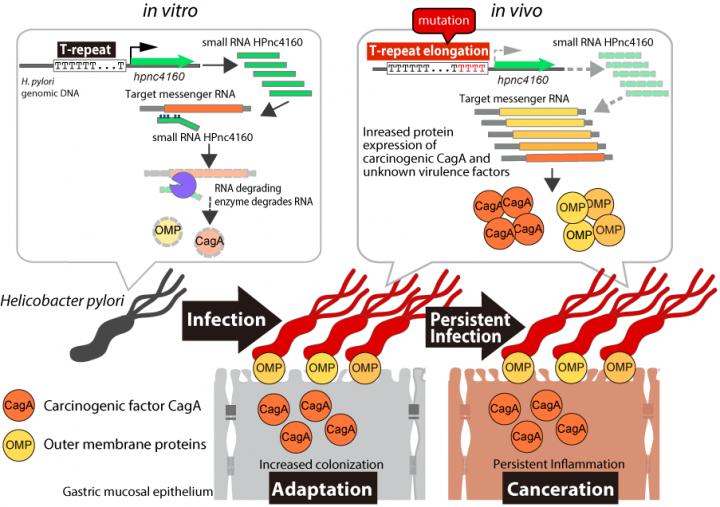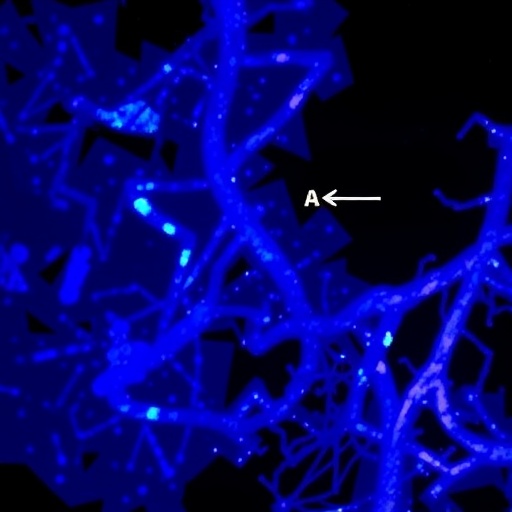Researchers from Osaka University identify a novel way of how a common bacterium can learn to live within the human stomach

Credit: Osaka University
Osaka, Japan – Humans are exposed to many types of bacteria daily, the majority of which are harmless. However, some bacteria are pathogenic, which means they can cause disease. An extremely common pathogenic bacterial infection is Helicobacter pylori (H. pylori) in the stomach, where it can lead to chronic inflammation (gastritis), ulcers, and even cancer. A group of researchers from Osaka University have determined a specific molecular mechanism that H. pylori uses to adapt to growing in the human stomach for long periods of time.
In a report published in Nature Communications, this group found that a small RNA molecule called HPnc4160 plays a key role in how H. pylori invades the stomach and leads to disease.
Previous studies showed that HPnc4160 is conserved in different strains of H. pylori, suggesting that it has an important function. Yet, the amount of this molecule produced in the bacteria is variable among strains. Genetic analysis revealed that a specific part of the H. pylori gene, called the T-repeat region, varied in length from strain to strain. The researchers became interested in how this region affected HPnc4160 expression. Additionally, they were curious how these fluctuations would allow some strains to colonize the human stomach more efficiently than others.
“Slight differences in the genetic sequence of H. pylori can sometimes give certain strains advantages over others that allow it to grow better,” says lead author of the study Ryo Kinoshita-Daitoku. “We were interested in the genetic and molecular reasons behind why particular strains are more pathogenic and can live in the stomach for decades, leading to cancer development.”
To address these questions, the researchers infected gerbils and mice with wild type (normal) H. pylori for 8 weeks, then extracted and genetically characterized the mutant strains that appeared. They discovered that strains with a higher number of T-repeats had lower expression of HPnc4160.
“We found that the H. pylori strains with low HPnc4160 levels were more infectious,” explains Hitomi Mimuro, senior author. “When this RNA was completely absent, the amounts of several bacterial pathogenic factors significantly increased and the strain showed stronger colonization within the rodent stomach.”
One of the pathogenic factors was the bacterial protein CagA, which is known as an oncoprotein because it can promote cancer development.
“Interestingly, we observed longer T-repeat regions, lower levels of HPnc4160, and higher levels of CagA in gastric cancer patients compared with those not suffering from cancer,” describes Kinoshita-Daitoku.
These novel findings provide crucial information regarding the molecular and genetic landscape of highly pathogenic H. pylori and may assist in the development of innovative therapeutics for the treatment of H. pylori related illnesses, including gastric cancer.
###
The article, “A bacterial small RNA regulates the adaptation of Helicobacter pylori to the host environment,” was published in Nature Communications at DOI: https:/
About Osaka University
Osaka University was founded in 1931 as one of the seven imperial universities of Japan and is now one of Japan’s leading comprehensive universities with a broad disciplinary spectrum. This strength is coupled with a singular drive for innovation that extends throughout the scientific process, from fundamental research to the creation of applied technology with positive economic impacts. Its commitment to innovation has been recognized in Japan and around the world, being named Japan’s most innovative university in 2015 (Reuters 2015 Top 100) and one of the most innovative institutions in the world in 2017 (Innovative Universities and the Nature Index Innovation 2017). Now, Osaka University is leveraging its role as a Designated National University Corporation selected by the Ministry of Education, Culture, Sports, Science and Technology to contribute to innovation for human welfare, sustainable development of society, and social transformation.
Website: https:/
Media Contact
Saori Obayashi
[email protected]
Original Source
https:/
Related Journal Article
http://dx.




